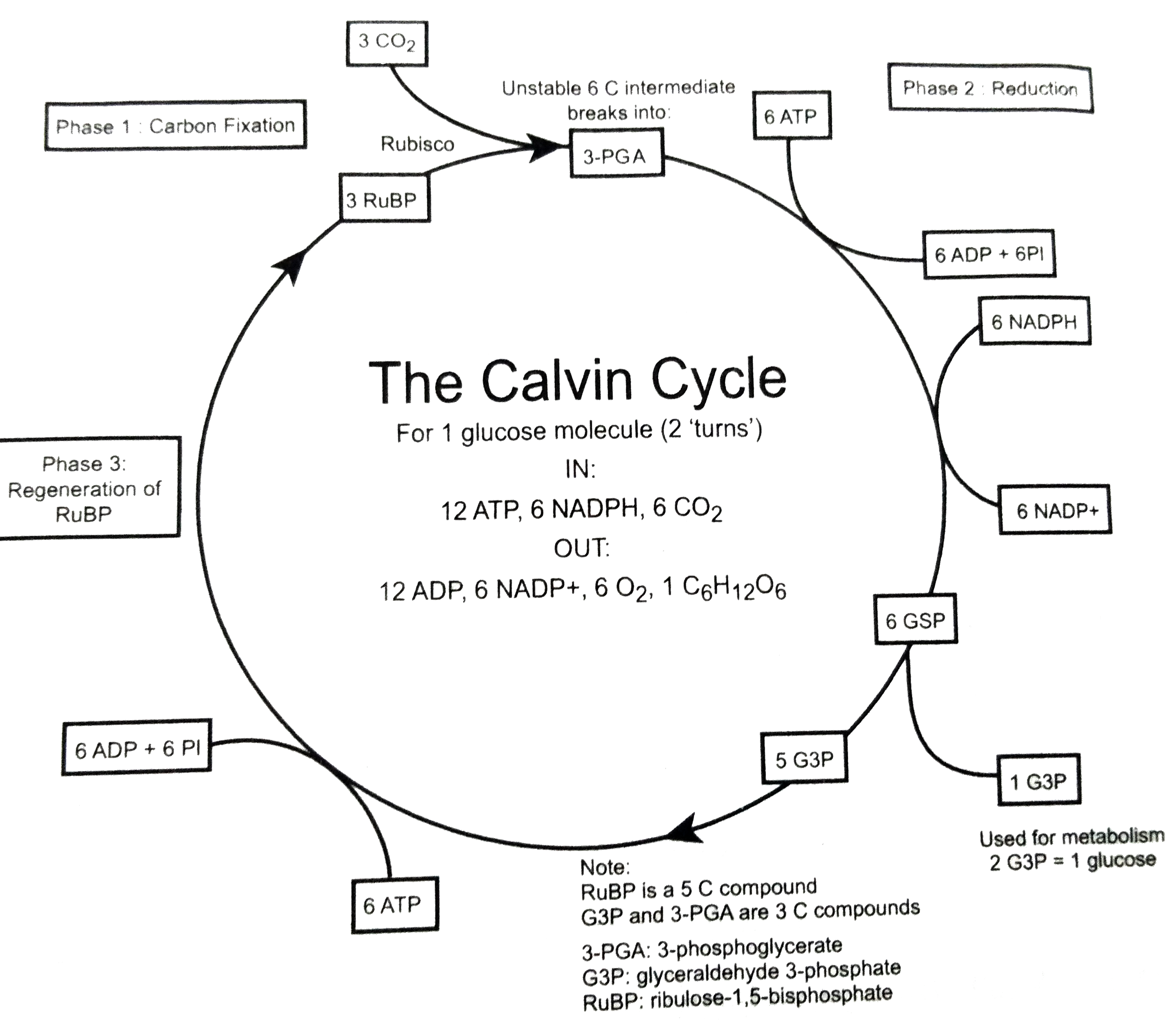What is dark reaction in photosynthesis ? Describe C3 Pathway.
Text Solution
Dark Reaction :
1. This is the second phase of photosynthesis in which CO2 is fixed or reduced to glucose. It occurs in the stroma of chloroplast.
2. It is independent of light (does not require direct light) hence called dark reaction.
3. The products of light reaction namely, ATP and NADPH2 are used here.
4. The presence of dark reaction was first established by Blackman hence also called "Blackman's reaction".
6CO2+12NADPH2+12H2O+18ATP→C6H12O6+12NADP++18ADP+18 Pi
Calvin Cycle (C3 Pathway):
1. Dr. Melvin Calvin in 1954 discovered the correct "path of carbon" in photosynthesis i.e. sequence of biochemical reactions of CO2 fixation into glucose.
2. He carried out experiments on unicellular green algae like Chlorella and Scenedesmus, and used radioactive isotope of carbon, C14 as a tracer.
The biochemical reactions leading to synthesis of glucose take place in cyclic manner are final product, glucose is produced in 90 seconds.
4. The initial accepter is regenerated so that it can accept CO2 again and keep the process going.
5. The first stable product is a 3-carbond compound, hence, Dr. Calvin called it C3 cycle, or C3 pathway, but it is more popularly known as Calvin cycle or Calvin-Benson cycle.

The cycle involves the following three main steps :
1. Carboxylation
2. Reduction.
3A. Synthesis
3B. Regeneration.
1. Carboxylation : Atmospheric CO2 is accepted by a 5-carbon compound called Ribulose-1-5-di-phosphate (RuDP) or Ribulose-1-5 bisphosphate (RuBP) in presence of enzyme RuDP carboxylase or RuBP carboxylase (RuBisCO) to from a 6-carbon unstable compound. Immediately it splits by hydrolysis into two molecules of 3-carbon compound called phosphoglyceric acid (PGA), in the presence of same enzyme.
RuBP(5C)+CO2(IC)Mg+−−−−−−−−−−→RuBP Carboxylaseunstable compound(6C)
Unstable(6C) compound+H2OMg++−−−−−−−−−−→RuBP Carboxylase2,3PGA(3C)
2. Reduction: (Utilisation of Assimilatory Power)
The Phosphoglyceric acid molecules are first phosphorylated by using ATP to produce 1, 3 di-phosphoglyceric acid which is then reduced using NADPH2 to produce phospho-glyceraldehyde (PGAL) and inorganic phosphate is released.
3PGA+ATP→1,3 di-PGA+ADP
1,3 di-PGA+NADPH2→3PGAL+NADP+iP
Some part of 3PGAL is converted into its isomer Dihydroxyacetone phosphate (DHAP) in the presence of enzyme triose-phosphate isomerase.
3A. Synthesis: For the synthesis of one glucose molecule, six turns of Calvin cycle are required or six molecules of RUBP and six molecules of CO2 are required.
1/6 part of PGAL i.e. out of 12 molecules, 2 are used for synthesis of glucose.
One molecule of PGAL and one molecule of DHAP combine together to from one molecule of fructose 1, 6-dephosphate.
3PGAL(3C)+DHAP(3C)→Fructose 1, 6-diphosphate.(6C)
By dephosphorylation it produces fructose-6-phosphate which when isomerizes into glucoss-6-phosphate. Glucose-6-phosphate loses a phosphate group (dephosphorylation) to produce glucose. Glucose is either utilized or stored as starch.
3B. Regeneration :
(a) RUBP gets regenerated through several biochemical reactions.
These reactions are called sugar phosphate interconversions.
(b) All the compounds/intermediates formed are sugar phosphates, for example, erythrose-4-phosphate (4-C), xylulose-5-phosphate (5-C), ribose-5-phosphate (5-C) sedoheptulose-7-phosphate (7-C) etc.
(c) 5/6 part PGAL, i.e., out of 12 molecules, remaining 10 molecules are used for regeneration of 6 molecules of ribulose mono-phosphate (RuMP).
(d) RuMP is phosphorylated to RuBP using ATP.
(e) For regeneration of 6 RuBP, 6 ATPs are required.
(f) Thus the initial acceptor of CO2 gets regenerated and keeps the process going (12NADPH2 and 18 ATP are required for synthesis of one glucose molecule).
C3 Plants :
(g) Most of the plants fix CO2 through Calvin cycle and are called C3 plants.
(h) RuBisCO is thermolabile and requires higher concentration of CO2 for its activity.
(i) At high temperature the stomata close partially so that availability of CO2 falls.
(j) At high temperature and at low CO2 concentration, RUBPcarboxylase, (i.e., RuBisCO-Ribulose Bis-phosphate Carboxylase Oxygenase), functions as oxygenase and brings about oxidation of RuBP instead of carboxylation.
(k) Due to this a considerable (approximately 25%) part of photosynthetically fixed CO2 goes back to atmosphere.
(l) This is called photorespiration.
|
Topper's Solved these Questions
Similar Questions
Knowledge Check
Dark reaction of photosynthesis is
AHill reactionBCalvin cycleCCyclic photophosphorylationDNon-cyclic photophosphrylation.Dark reaction of photosynthesis is
AHill reactionBCalvin cycleCCyclic photophosphorylationDNon-cyclic photophosphorylationDuring dark reaction of photosynthesis
AWater splitBCO2 is reduced to organic comoundsCChlorophyll is activatedD6 carbon sugar is broken down into 3 carbon sugar

